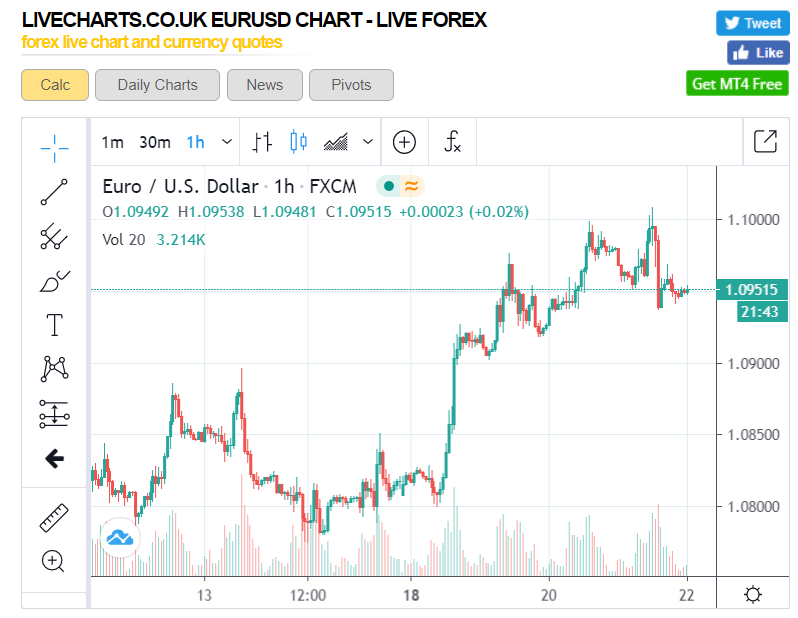Summary: Tensions between the US and China heightened after the Trump administration tightened control on the use of its technology by Huawei which threatened “phase one” of a trade deal agreed between the two countries. The US Senate also passed a bill that could see some Chinese companies delisted from US exchanges. China warned that it would safeguard its sovereignty and interests, threatening countermeasures. US President Trump said that his country would react strongly if China imposes national security laws for Hongkong in response to last year’s pro-democracy protests. Risk currencies slid, led by the Australian Dollar, down 0.40% to 0.6567 (0.6600). The Kiwi (New Zealand Dollar) fell 0.44% to 0.6125 (0.6150 yesterday). The Euro retreated 0.3% to 1.0947 after hitting a peak at 1.10083 despite an overall improvement in Euro area Manufacturing and Service PMI’s and a weaker US Jobless Claims report. Against the Japanese Yen, the Dollar was little changed at 107.60 (107.58) ahead of today’s Bank of Japan interest rate policy meeting and announcement. The Dollar rebounded against the Canadian Loonie to 1.3955 from 1.3907. Wall Street stocks eased on the souring of risk appetite. In late New York, the DOW was down 0.68% to 24,438 (24,615). The S&P 500 lost 1.14% to 2,943 from 2,977 yesterday. Global bond yields were mostly lower. The benchmark 10-year US treasury yield closed at 0.67% (0.68%). Germany’s 10-year Bund yield was three basis points lower to -0.50%.

Data released yesterday saw French and Eurozone Manufacturing PMI’s beat forecasts at 40.3 (26.0) and 39.5 (38.0) respectively. Germany, however missed expectations with its Manufacturing PMI down to 36.8 from 39.3. Euro area Services PMI’s were all better than expected. UK Manufacturing and Services PMI’s also beat expectations, at 40.6 (35.1) and 27.8 (24.1) respectively. US Flash Manufacturing PMI rose to 39.8 from the previous 36.1, bettering forecasts at 37.5. Services PMI rose to 36.9 in April from 26.7 in March, beating expectations of 32.6. US Philadelphia Manufacturing PMI rose to -43.1 in April from the previous month’s -56.6, missing forecasts at -40.0.
On the Lookout: Another case of risk-on, risk-off yet again as trade tensions mount between the US and China. There is no doubt that US President Trump is increasing his criticism of the Chinese Communist Party leadership as he faces a re-election challenge later this year. Which could derail any economic global recovery already reeling from the coronavirus outbreak even as lockdown restrictions are eased and businesses restart. Traders will continue to monitor those developments.
Today’s economic calendar saw New Zealand’s Q1 GDP, just released dip to -0.7% from a downward revised Q4 GDP of 0.0% (from 0.7%), but better than forecasts at -1.5%. NZD/USD stayed flat at 0.6125.
Japan reports on its National Headline and Core CPI data. The Bank of Japan is expected to keep its Policy rate unchanged at -0.10% at the conclusion of its emergency meeting today. Traders will focus on BOJ President Kuroda’s press conference following the meeting (later this afternoon, Sydney time). Europe sees the release of the ECB’s Monetary Policy Meeting Accounts. UK Headline and Core Retail Sales for May and Public Sector Net Borrowing reports follow. Canada’s Headline and Core Retail Sales round up the day’s reports.
Trading Perspective: FX still finds itself trading within ranges with the excitement of any break outs contained so far. No one really knows what the catalyst will be for any break in direction. Until then, the recent established trading ranges are intact. The rising tensions that are threatening “phase one” of the China-US trade deal reached early this year will continue to support the safe-haven Greenback.
AUD/USD – Slip Sliding Away on Risk-Off, Failure to Break 0.6600
The Australian Battler found itself slip sliding away on the back foot after risk sentiment soured on the heightened US-China tensions. AUD/USD closed at 0.6565 after trading to an overnight high at 0.6598 and its 0.6600 opening yesterday. Earlier this morning, ratings agency Fitch revised Australia’s Outlook to Negative while affirming its “AAA” rating. According to Fitch, the Negative Outlook” reflects the significant impact the global coronavirus pandemic has on Australia’s economy and public finances. Growth will fall sharply in 2020 and government spending in response to the health and economic crisis will cause large fiscal deficits and a large increase in the government debt/GDP. The AUD/USD pair did not react to the negative news, stuck at its current 0.6565 level.

Australia’s recent trade war with China threatened to spill over to its most valuable export, iron-ore. The Guardian reported that China’s customs officials are imposing new inspection procedures and rules from next month, which could be used to block or hold up Australian shipments. But miners and Australia’s trade minister say the changed inspection regime could actually streamline Australian Iron ore imports. According to the Communist party-run Global Times, the Australian imports could be damaged by worsening tensions between Canberra and Beijing. Aussie traders will continue to closely monitor these developments.
AUD/USD has immediate resistance at 0.6600 followed by 0.6630 today. Immediate support can be found at 0.6550 (overnight low 0.65488) and 0.6520. Look for consolidation today with a likely range trade between 0.6485-0.6595. Prefer to sell rallies.
EUR-USD – Retreating Below 1.1000 After German Factory PMI Undershoots
The Euro retreated from the 1.1000 resistance area after trading to a peak at 1.10083, finishing in later New York at 1.0947. Euro area Manufacturing and Services PMI’s all bettered forecasts with the one disappointment, Germany’s Manufacturing PMI which printed at 36.8, missing median expectations at 39.3. Increased confidence in the shared currency due to optimism from the Franco-German agreement for a Euro 500 billion proposal to aid coronavirus hit economies has seen EUR/USD rally over 1.5% this week.

Speculative long Euro market positioning remains the headwind for the shared currency. Immediate support can be found at 1.0935 followed by 1.0915 and 1.0875. Immediate resistance lies at 1.1010 and 1.1030. There are no major economic data releases out of Europe today apart from the release of the ECB’s Monetary Policy meeting accounts. Its one of those days when the best strategy is to respect the ranges. Best not to get too carried away with sentiment. Likely range today 1.0880-1.1010. Preference is to sell rallies.












